Fibromyalgia Basics
Strengthening Legs with Isometrics
Home | Fibro Friendly Exercises
Ken Lamm, P.T., of Tucson, AZ, shows how to tone muscles without draining the energy bank. The key is to build strength through stationary muscle contractions and avoid placing pressure on joints. Ken explains that “a six second contraction two times twice a day is equivalent to an hour of calisthenics.” In this article, Ken uses the isometric concept to provide lower body toning in the quadriceps, hamstrings, calves, ankles, and toes. With five easy exercises, you can improve your strength, joint stability, and balance in just ten minutes a day.
When performing isometric exercises, Ken recommends “to start and stop slowly so that you are not jerking the joint or fast starting the muscle.” No pain should be felt while doing any of these isometrics. It is also important to maintain a good but relaxed upright posture because the focus should be on your legs. When holding a muscle contraction, it is easy to forget to breath. To help remind you to breath throughout the full exercise, try to count out loud even if it is just a whisper.
For all exercises, hold the muscle contraction six seconds, relax and then hold it again. Perform two repetitions twice daily for the best results.
Hip Action
To strengthen the muscles that allow your hips to rotate, sit in a chair, cross your ankles, and keep your knees about six inches apart. Try to pull your feet apart but without actually moving them. Then switch feet and perform the isometric with your other leg in front (Figure 1). You will feel this exercise on the outer side of your hips.
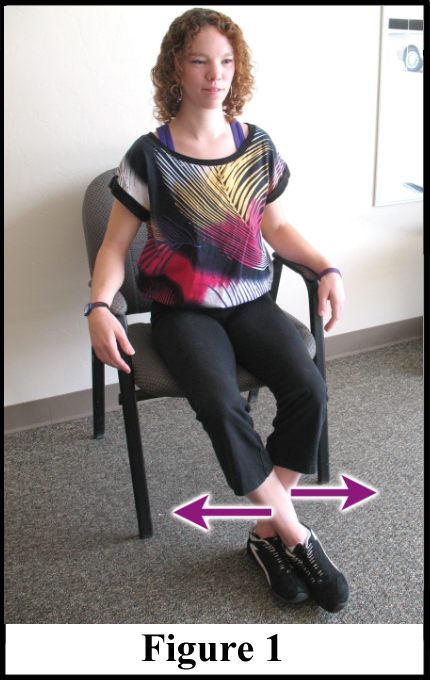
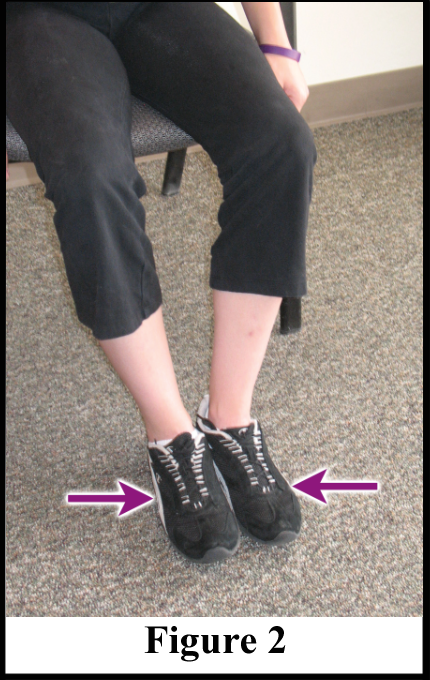
Now place your feet side by side with six inches still between your knees. Push the inner sides of your feet together (Figure 2). This muscle contraction will strengthen your inner thighs.
Quad and Hamstring
Ken explains that “the quads are stronger than the hamstrings because the hamstrings are seldom used. However, you do use your hamstrings when you lift your leg up to walk and move forward. If you are climbing upstairs or squatting down to pick something up, you are using your quads to perform those movements.” The strength that the quadriceps and hamstrings provide is important for everyday activities.
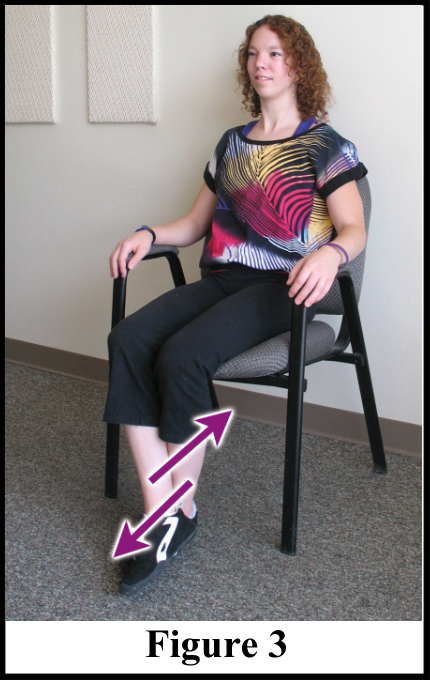
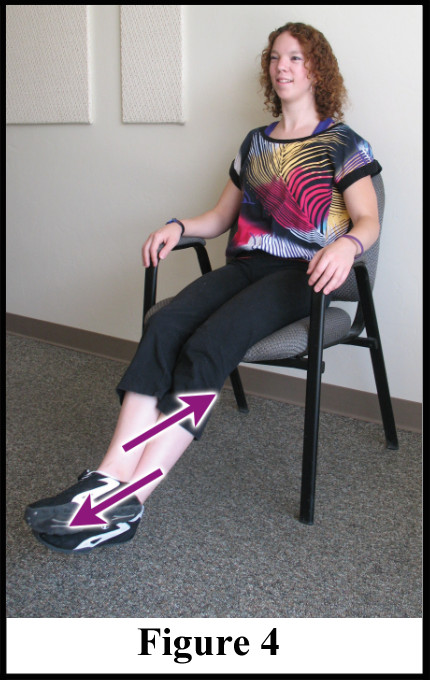
For the next exercise, cross your feet with your knees bent at a 90-degree angle, try to kick one leg forward as you apply resistance with the other leg in the opposite direction (Figure 3). Move your legs out to 45 degrees and perform the same isometric at this angle (Figure 4). Extend your legs all the way out and perform the exercise once more (Figure 5). Then switch and repeat with your other leg crossed in front.
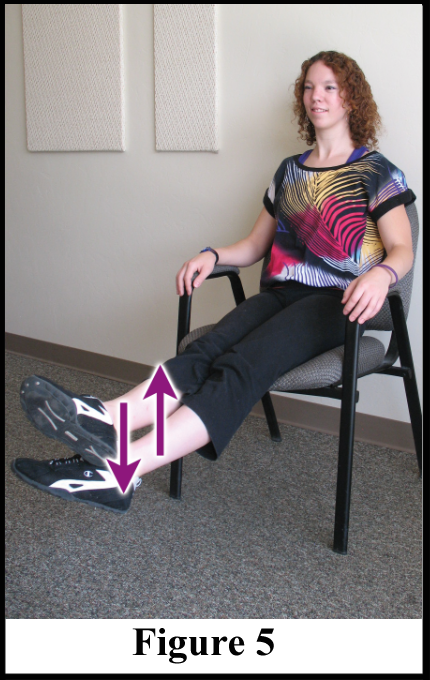
Ken explains that “you need strong muscles to get out of the chair, halfway up, and then all the way to standing. Different muscles in the quad and hamstring groups become activated at the various elevations during this movement. To strengthen all the muscles, you must perform the exercise at the varying angles.”
“It’s easier on the back if you scoot all the way into the chair to give you more support for your back and legs,” says Ken. “Many people have tight hamstrings and the additional chair support for the thighs is needed.”
Ankle and Toe Stability
“You have three areas of balance throughout your body. Your ankles are number one. They are like the foundation for your house. If you don’t have a good foundation then nothing else matters.” Without good ankle stability, you can sprain your ankles walking on uneven ground. To strengthen these muscles, find an immovable object around your house or work environment with 1½ inches of space to slide your feet under. This object could be a sofa, under a cabinet at your desk, or under the bottom of a bookshelf (Figure 6).
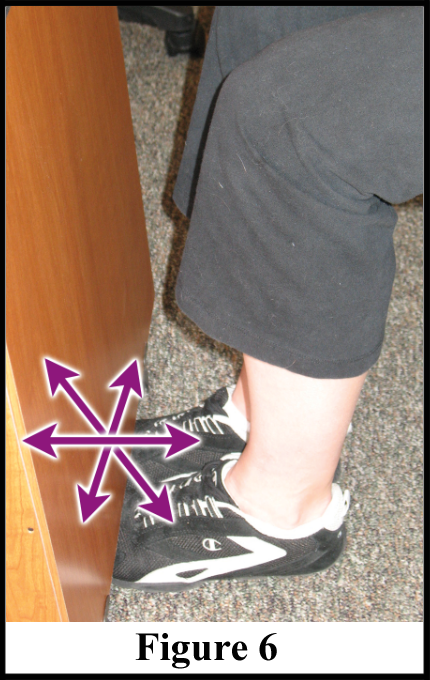
Sit in a chair directly in front of the object with your knees bent to 90 degrees and your feet side by side in closed-toed shoes. For added comfort, you may wish to place a towel between your feet and the immovable object.
The purpose of this isometric is to activate the muscles of the calves and ankles as though you were moving your toes around a large clock in front of you. However, you don’t actually move your feet because they are comfortably tucked in under an immovable object.
Start by pretending to pull your feet up to the 12 o’clock position and notice how this contracts the muscles along your shin bone and the top of your feet. Continue in a clockwise pattern, trying to move your feet to the 2, 4, 6, 8, and 10 o’clock positions. Note that when you are at 6 o’clock this strengthens the back of the calves. All six contractions should be held for six seconds.
“No matter how you attempt to move your feet, you will be exercising your calf and ankle muscles,” says Ken. These isometrics will improve your ankle motion awareness, gait pattern, and ability to go for a stroll around your neighborhood or navigate your footing on a nature walk.
When you shift your body weight while standing, your ankles are key to the balancing act but your toes help as well. Increasing toe strength is also important for a good foundation. For this next exercise you will be performing the same clockwise motions, but now specifically just for the toes.
Sit in a chair with your feet placed together on the ground in closed-toed shoes. Your shoes will be your resistive force in this set of isometrics. Simply pull your toes toward the top of your shoes, then pull them apart, and push them down. Make sure to hold each direction for six seconds to keep your toes strong.

Weak Leg Muscles?
It’s not your imagination
More than half of fibromyalgia patients may have significantly less knee muscle strength than healthy people according to a team of researchers in Denmark.1 These results are based on a large group of 840 fibromyalgia patients, so their finding that 52 percent of them had reduced leg strength is certainly no fluke.
Pain and exhaustion can contribute to a vicious cycle of reduced activity, loss of muscle strength and impaired physical functioning, but it is not clear that this is what is happening in people with fibromyalgia. The researchers tested the hypothesis that fibromyalgia patients with less knee strength would have greater symptom severity than those with normal strength. Pain and functional measures were used to assess symptom severity.
Knee muscle strength in both directions (flexion and extension) was measured with subjects in a seated position. Flexing the lower legs backward relies heavily on the strength of the hamstring muscles in the back of the thighs. Extending the legs out uses the quadriceps (or quads), which is a group of four large muscles in the front thighs.
As it turned out, symptom severity did not correlate at all with the knee strength measures. The lack of correlation with the symptom severity was a surprise because weakness in the leg muscles is usually a strong predictor of reduced walking speed and poor balance.
On a positive note, a study using gentle lower body strengthening exercises was found to be very beneficial for improving balance and function in fibromyalgia.2 So the muscles are trainable and the isometric exercises offered above should do the trick.
- Henriksen M, et al. Arthritis Rheum 61:732-739, 2009.
- Tomas-Carus P, et al. Rheumatology 48:1147-51, 2009.
